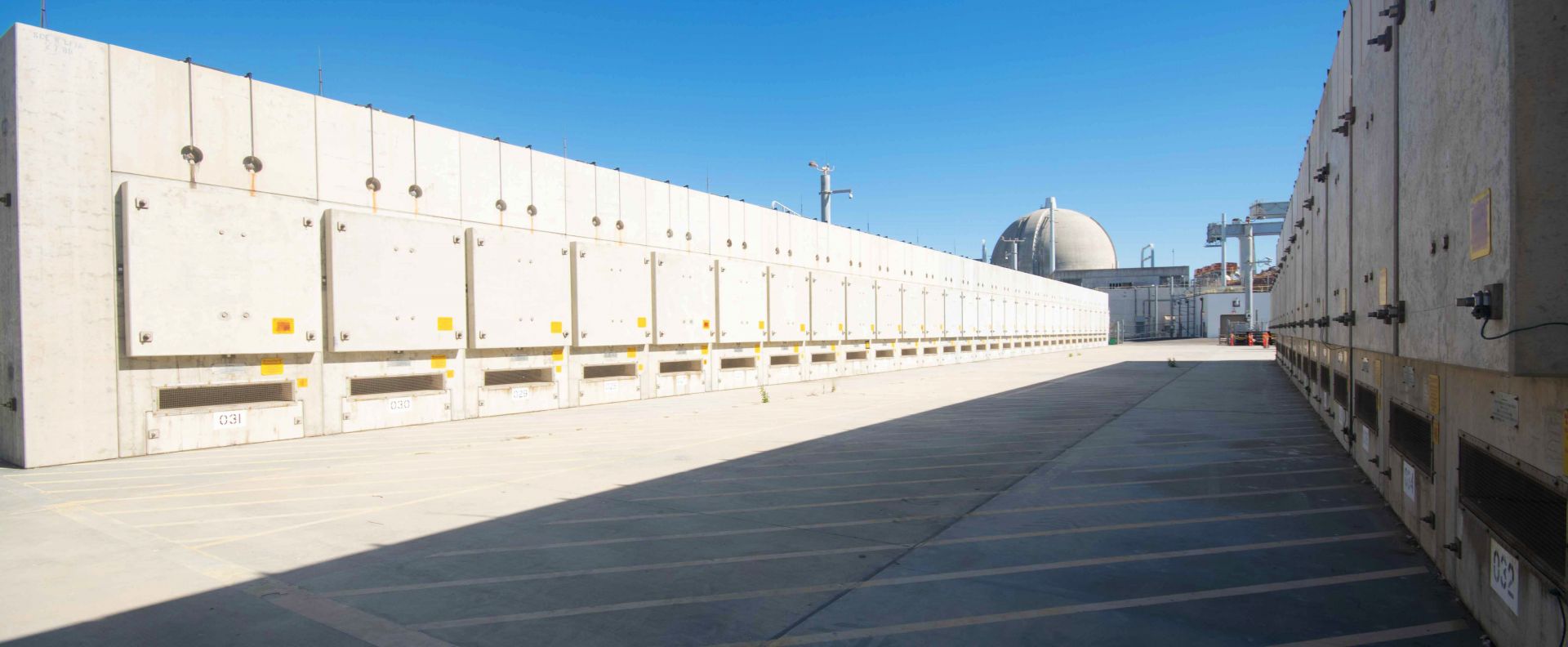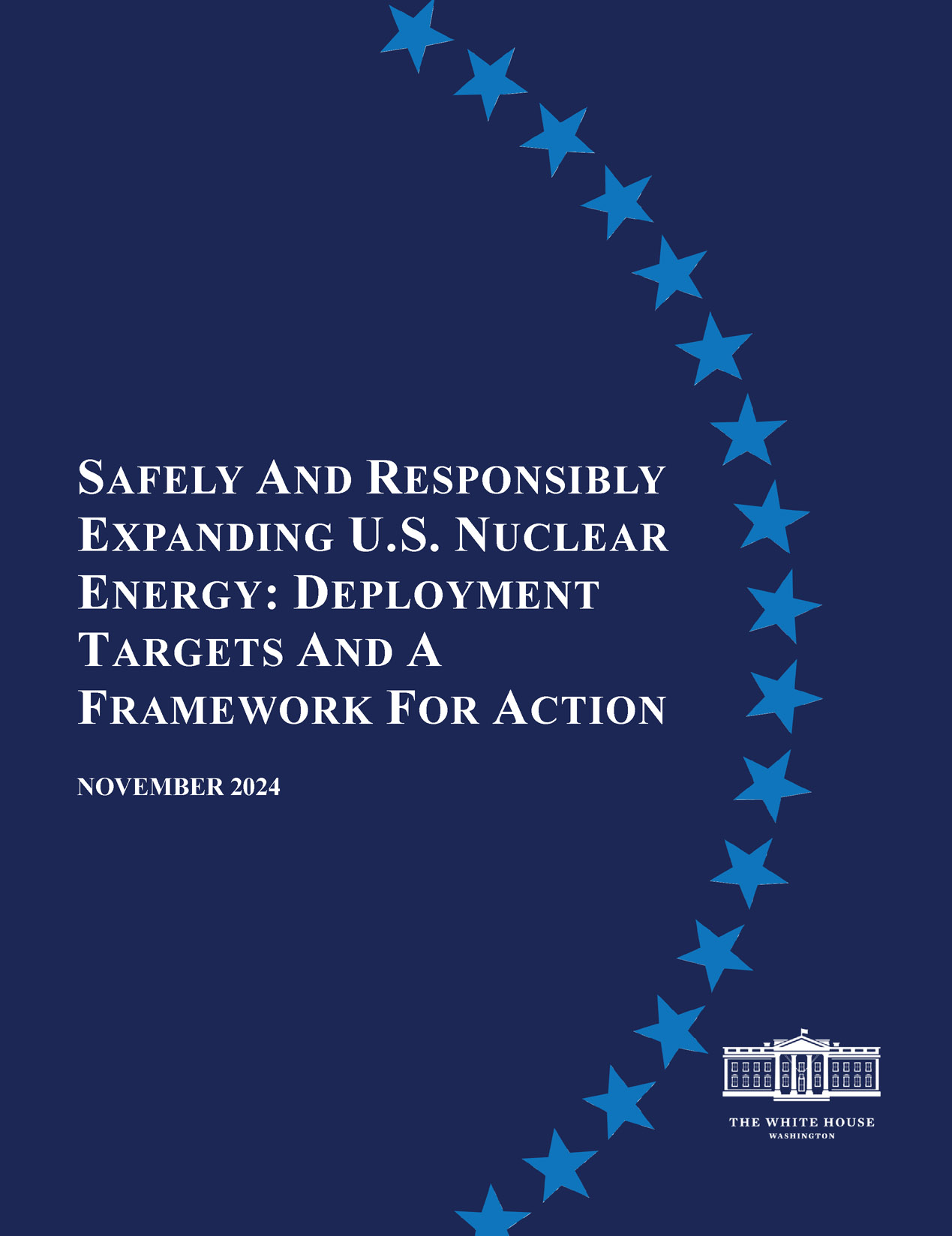Bernard Fontana (left) of Framatome and Cosmin Ghiță of Nuclearelectrica. (Photo: Framatome)
Framatome and SN Nuclearelectrica, a partially state-owned Romanian nuclear energy company, have entered into a long-term cooperation agreement to produce the medical isotope lutetium-177 at Cernavoda nuclear power plant in Romania. Lu-177 is a beta-emitting radioisotope used in targeted radionuclide therapy for the treatment of neuroendocrine tumors and prostate cancer.
The Orano TN-NUHOMS dry fuel storage system at San Onofre Nuclear Generating Station. The system holds 50 canisters of spent nuclear fuel. (Photo: SONGS)
The Department of Energy has started over on the quest for a place to store used fuel. Its new goal, it says, is to foster a national conversation (although this might better be described as many local conversations) about a national problem that can only be solved at the local level with a “consent-based” approach. And while the department is touting the various milestones it has already reached on the way to an interim repository, the program is structured in a way that means its success will not be measurable for years.
INL team removing and staging irradiated ANEEL fuel rodlets in the ATR canal. (Photo: Clean Core)
November 15, 2024, 7:03AMNuclear NewsErhard W. Koehler and Anne Jennings N.S. Savannah, the first commercial nuclear-powered cargo vessel, en route to the World’s Fair in Seattle in 1962. (Photo: U.S. National Archives)
It’s safe to say that readers of Nuclear News are familiar with decommissioning. It’s even safe to assume that experienced decommissioning practitioners are familiar with the National Historic Preservation Act (NHPA) and how it applies to typical projects. What’s different about the N.S. Savannah is that the entire project site is a historic property—and in fact, is a federally owned National Historic Landmark (NHL), a status that confers the highest level of protection under law. Federal owners of NHLs are obligated to minimize harm in both planning and actions. Distilled to its salient point, no federal owner of an NHL should destroy it if there’s a reasonable alternative. That level of preservation is not what we normally associate with nuclear decommissioning. This perfectly summarizes the challenges, and opportunities, that decommissioning Savannah offered. The story of how the Maritime Administration (MARAD) managed these two otherwise contradictory processes showcases how historic preservation and decommissioning can positively intersect, provides a pathway for other historic facilities, and further adds to the already illustrious history of one of our nation’s significant 20th century landmarks.
A view of Oklo’s preferred site at INL. (Photo: Oklo)
Oklo Inc. announced yesterday that it has partnered with “two major data center providers” under letters of intent (LOIs) to deliver up to 750 MW of power from multiple 15 MW or 50 MW Oklo microreactors at data centers in “select” undisclosed U.S. markets.
The DUF6 facility at the Paducah Site in Kentucky. (Photo: DOE)
The Department of Energy’s Office of Environmental Management has awarded a $2.3 billion operations and site mission support services contract for the Portsmouth Paducah Project Office (PPPO) to Mission Conversion Services Alliance (MCSA), a limited liability company made up of Atkins Nuclear Secured, Westinghouse Government Services, and Jacobs Technology, with Swift & Staley and Akima Centerra Integrated Services as teaming subcontractors.
The ASA Nuclear Technology for Marine Propulsion class of 2024 poses at MIT. (All photos: MIT Department of Nuclear Science and Engineering)
Some 30 nuclear engineering departments at universities across the United States graduate more than 900 students every year. These young men and women are the present and future of the domestic nuclear industry as it seeks to develop and deploy advanced nuclear energy technologies, grow its footprint on the power grid, and penetrate new markets while continuing to run the existing fleet of reactors reliably and economically.
The decommissioned USS Enterprise alongside her replacement, USS Gerald R. Ford, at Newport News, July 2018. (U.S. Navy photo by Mass Communication Specialist 2nd Class Kiana A. Raines)
NorthStar Group Services announced it will work with Modern American Recycling Services (MARS) to pursue work dismantling and disposing of decommissioned U.S. Navy nuclear aircraft carriers at the Port of Mobile, Ala. The work is to be performed by NorthStar subsidiary NorthStar Maritime Dismantlement Services and MARS subsidiary Modern American Recycling and Radiological Services.
The Diablo Canyon ISFSI cask loading team from Holtec, PG&E, and Diablo Canyon. (Photo: Holtec)
Holtec International announced that it has completed the campaign to transfer Diablo Canyon’s spent nuclear to dry storage ahead of its planned schedule, paving the way for the continued operation of the central California nuclear power plant.
COP29 takes place November 11–22, in Baku, Azerbaijan. (Photo: Adobe Stock)
As COP29 kicked off November 11, industry advocates worldwide are hoping to draw attention and increase buy-in to the need for more nuclear capacity.
A 3D, semitransparent model of the TMI-2 reactor building is helping planners and workers visualize the work to be done in the radiologically controlled building. (All photos: Tim Gregoire)
Constellation Energy has announced that it will seek to restart Unit 1 of the Three Mile Island nuclear power plant in Pennsylvania as part of an agreement with Microsoft to power that company’s data centers. Given the growing interest by tech companies in using clean, reliable nuclear power to meet their growing energy demands, the September 20 announcement to reopen TMI-1, which was shut down and defueled in 2019, was not a huge surprise.
The H9 Hall thruster, developed at UMich’s Plasmadynamics and Electric Propulsion Laboratory. (Image: William Hurley/University of Michigan)
Seeking spacecraft that can “maneuver without regret,” the U.S. Space Force is investing $35 million in a national research team led by the University of Michigan to develop a spacecraft with an onboard microreactor to produce electricity, with some of that electricity used for propulsion. But this spacecraft would not be solely dependent on nuclear electric propulsion—it would also feature a conventional chemical rocket to increase thrust when needed.













 As the United Nations’ COP29 climate summit kicked off this week, President Biden’s administration laid out plans to add 200 GW of nuclear power in the next 25 years through a combination of new reactor deployment, plant restarts, and upgrades at existing sites.
As the United Nations’ COP29 climate summit kicked off this week, President Biden’s administration laid out plans to add 200 GW of nuclear power in the next 25 years through a combination of new reactor deployment, plant restarts, and upgrades at existing sites.





